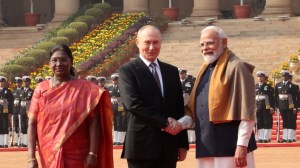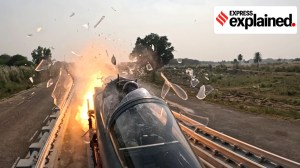In Part 1, Nanavati concludes Part 2
The commission has said that second part of probe report covering subsequent riots that had killed hundreds in Gujarat, will be submitted separately by Dec 31.

The Justice G T Nanavati Commission probing the 2002 Godhra train incident and the communal riots in its aftermath has reported that the fire on board the Sabarmati Express on February 27, 2002 at the Godhra railway station that killed 59 kar sevaks returning from Ayodhya was the result of a pre-planned conspiracy involving “some individuals.”
The first part of the report — dealing only with the train incident — was tabled in the Gujarat Assembly on Thursday, over a week after Nanavati handed over the first copy to Gujarat Chief Minister Narendra Modi.
The commission has said that the second part of the probe report covering the subsequent riots that had killed hundreds in Gujarat, will be submitted separately by December 31, before the 12th extension of its term expires.
But, surprisingly, while the report makes it clear that “there is absolutely no evidence to show that either the Chief Minister and/or any other Minister(s) in his Council of Ministers or Police Officers had played any role in the Godhra incident,” it goes on to give a clean chit to the government on what followed.
It says there is no evidence of “any lapse in providing protection, relief and rehabilitation to victims of the communal riots and in the matter of not complying with the recommendations and direction given by the National Human Rights Commission.”
In other words, the Modi government has been absolved even before the second part of the report is tabled.
The report says that after the Sabarmati attack conspiracy was hatched, three of the accused, Jabir Behra, Rajak Kurkur and Salim Panwala, bought and stored 140 litres of petrol from a local petrol pump the previous night and took it away in containers loaded on a rickshaw. Citing confessions of some of the accused, the report says it was these containers that were thrown into coach S6 triggering the blaze.
The next day, the conspirators floated a rumour that a Muslim girl had been abducted, so as to collect a large crowd near the train and induce them to attack it. This, the Commission says, was done so as to allow enough time for the conspirators to approach the train carrying the petrol, and also to later attribute the burning to mob fury. But the Commission has stressed, the mob could not have set coach S6 on fire on the basis of this false rumour, and instead it would have tried to stop the train, search for the abducted girl and rescue her.
This is the sequence of events the Commission cites:
• While the train was still at the platform, a mob outside the station premises at Signal Falia began stoning its front coaches.
• Once the train began moving out, it was chased and attacked with stones
• Alarm chain was pulled, the train stopped near A Cabin
• Mob converged on it shouting slogans like ‘Maaro, Kapo, Jala do’ and began attacking it
• Some in the mob targeted S6 and broke its widows on the Signal Falia side
• Stones, burning rags and pouches filled with inflammable liquid were thrown into the coach through the open windows, causing smoke and fire
• The sliding door on S6 coach connecting it to S7 was forcibly opened and “something was thrown in”, causing a big fire.
• The sliding door between S6 and S7 appeared to have been forcibly opened as there were marks of violence on the outer side of the door and scratch marks on the inner side.
• 60 litres of petrol were poured on the floor of the coach.
“All acts like procuring petrol, circulating the false rumour, stopping the train and entering S6 coach were in pursuance of the object of the conspiracy”, according to the commission.
One of the arguments made before the commission against the conspiracy theory — that it rejected — was that even the police was not in the know of details about the return journey of Karsevaks from Ayodhya and so no conspirator could have known it.
“Merely because the police was not aware about the return journey of the Karsevaks from Ayodhya, it would not follow therefrom that no one had known about their return journey from Ayodhya. Anyone who wanted to know about it could have obtained that information easily. Therefore, it would not be correct to say that there was no scope for any conspiracy,” the report said.
The conspirators, according to the commission’s inferences, had planned to burn a coach of this train as it was scheduled to pass through Godhra at night and the dark would have helped them to do it without being identified. “It appears that because the train was running late, they had to make some changes in their plan and circulate a false rumour regarding the abduction of a Ghanchi Muslim girl,” so as to do the act in daylight, under cover of an irate mob.
The Commission report has also highlighted that the train-burning conspiracy was part of a larger conspiracy involving a string of people including Nannumiya, Maulvi Umarji, Rajak Kurkur, Salim alias Salimyusuf Sattar Jarda, Salim Panwala and others. Nannumiya, the report said, used to meet the other accused at a local lodge and instigate them to do something in Godhra the way Muslim outfits did in Kashmir.
The Commission has given a clean chit to Chief Minister Narendra Modi and his ministers in the incident, and underlined that no religious or political organization had a hand, either.
The report says: “There is absolutely no evidence to show that either the Chief Minister and/or any other Minister(s) in his Council of Ministers or Police Officers had played any role in the Godhra incident.
- 01
- 02
- 03
- 04
- 05































